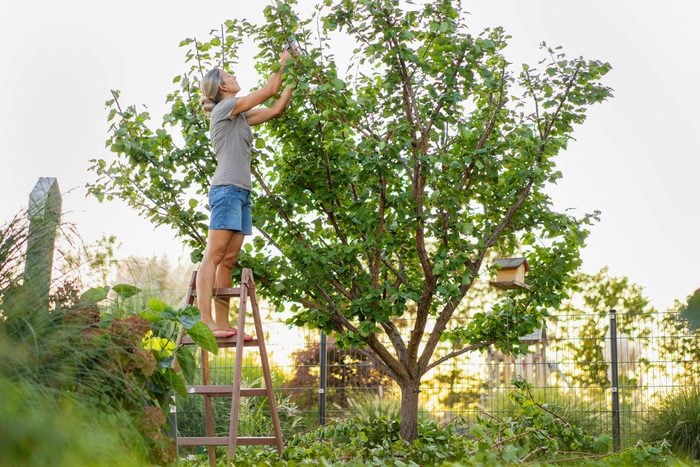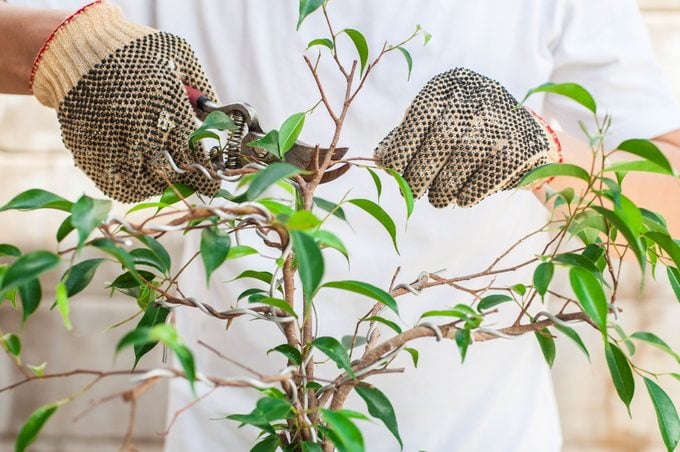How To Help Your Trees, By Season
Updated: Dec. 15, 2023

A little care can help boost tree health for years to come. Here's a quick guide for when to prune, mulch, water and more.
Trees are our stalwart companions, strong and loyal, but we often overlook their care. Just like your garden and lawn, they need some attention to stay vibrant and reach their full potential.
“By performing a few essential tasks, you not only enhance the beauty of your surroundings but also contribute to the well-being of your green companions,” says Kathy Glassey, a senior consultant at Inspire Green. “Your efforts will be rewarded with shade, beauty and a thriving ecosystem in your own backyard.”
Most trees follow similar seasonal cycles, though those are less apparent in places like the South. Yes, even palm trees are often dormant in the winter. So caring for trees is similar across the country.
Specific tree needs also vary by climate and species. Consult a local arborist for advice on choosing fertilizer, dealing with possible diseases and infestations and any other questions you have.
Otherwise, here’s what to know about helping your trees, by season.
On This Page
Spring Tree Care
Spring is the perfect time to set up your trees for success the rest of the year.
“Winter can be tough on trees, so it’s important to inspect them for any damage or disease as soon as the weather warms,” says Travis McDonald, district manager for the Davey Tree office in south Minneapolis, Minnesota. “Look for broken branches, cracks in the trunk and signs of pests or diseases, such as discolored leaves, cankers and holes.”
In addition:
- Prune problematic branches or fronds to encourage healthy growth and prevent potential property hazards. Pruning also improves a tree’s aesthetic and shape. Prune carefully with clean, sharp tools. Do not prune fruit trees in the spring. For other flowering trees, wait until after they’ve bloomed.
- If you’re in a dry climate, water trees, especially newly planted ones and evergreens. A slow, deep watering will encourage better root growth than more frequent shallow waterings.
- Apply organic mulch around the base to retain moisture, regulate soil temperature and suppress weeds. Mulch two to three inches deep, but don’t put it against the trunk, which can create rot and disease. You should see some root flare, where the trunk and main roots meet.
- Add soil amendments and organic matter, because trees are actively growing. Choose a balanced, slow-release fertilizer to avoid overfeeding.
- Watch for signs of infestation or illness, since pests and diseases become active in the spring. Early detection and intervention are key. If you suspect something might be amiss, promptly contact a certified arborist for advice about treatments and other courses of action.
- Plant new trees in locations appropriate for their size once they reach maturity.
Summer Tree Care

Summer sun and heat are blessings and challenges for trees. A lot of your summer care will depend on how much natural precipitation you get, and how established your trees are.
- Deeply water trees in dry climates, especially young and newly planted ones. The frequency varies by location, but in dry places that will probably be once a week or more. Watch for signs of drought and stress, like wilting leaves or yellowing foliage. Aim for early morning or late afternoon to minimize evaporation. Don’t water directly at the trunk. Instead, water out as far as its canopy’s drip line, i.e. the outermost edge of the tree’s foliage, or the circumference out to where it sheds rain.
- Light pruning and deadheading is OK, but too much warm weather pruning stresses trees and makes them susceptible to disease. Especially try to avoid pruning oaks, elms and fruit and nut-bearing trees when they’re not dormant, unless they pose a safety hazard.
Fall Tree Care
Preparing your trees for the colder months is essential to ensure their health and vitality come springtime.
- Continue to water them deeply so they have enough moisture to store for the winter. However, by fall it’s OK to allow the top few inches of soil to dry out between waterings. Stop once the ground freezes.
- It’s good to leave some leaves under the tree to act as natural mulch, protecting roots from the cold and providing habitat and food for pollinators/larvae and nesting birds. Don’t leave more than two to three inches, though. More than that will compact quickly and become a potential problem with disease. If you find indications of disease, remove all leaves from the base of the tree. You can also leave leaf piles elsewhere in your yard to help the ecosystem. Compost excess leaves.
- Prune away dead and diseased branches to prevent the spread of disease and encourage new spring growth. Fall is an ideal time for this as you can see problem branches better once the leaves are gone.
- Add soil amendments like a slow-release fertilizer specifically for trees. This will help trees store essential nutrients for the winter, promoting healthy spring growth.
- Protect young or cold-vulnerable trees near the edges of their USDA Hardiness Zone by wrapping the trunk with burlap. This minimizes winter frost cracking, i.e. where the bark freezes and the tree splits open. Do the same for damaged trees.
- Inspect trees for diseases and pests to prevent infestations from worsening over the winter.
Winter Tree Care
In most climates, trees go dormant in the winter. That makes winter an especially ideal time to prune deciduous species, reducing the risk of branches breaking under heavy snow and ice.
Also:
- Use plastic guards or tree wraps on young, vulnerable trees if wildlife like rabbits and deer feed on twigs and bark.
- Avoid using de-icing salts near trees, because they leach into the soil and harm tree roots. Instead, opt for sand or calcium chloride to make your sidewalks less slippery.
- Avoid watering trees when it’s freezing outside. You can, however, periodically mist trees (especially evergreens) to help them lock in moisture and slow evaporation.
- Regularly inspect trees for signs of cold-related stress or pest damage. Look for cracks, splits and peeling bark.
- Remove heavy snow by gently shaking branches or brushing it away. Avoid shaking branches coated with snow and ice, which might snap.
